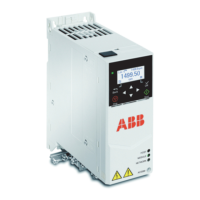Program features 61
Motor control
Motor types
The drive supports the following motor types:
• Asynchronous AC induction motors
• Permanent magnet (PM) motors
• Synchronous reluctance motors (SynRM).
Parameters and diagnostics
Parameters: 99.03 Motor type
Motor identification
The performance of vector control is based on an accurate motor model determined
during the motor start-up.
A motor Identification magnetization is automatically performed the first time the start
command is given. During this first start-up, the motor is magnetized at zero speed
for several seconds to allow the motor model to be created. This identification method
is suitable for most applications.
In demanding applications a separate Identification run (ID run) can be performed.
Parameters
Parameters: 99.13 ID run requested
Power loss ride-through
See section Undervoltage control (power loss ride-through) on page 84.
Vector control
Vector control is the motor control mode which is intended for applications where high
control accuracy is needed. It requires an identification run at startup. Vector control
cannot be used in all applications.
The switching of the output semiconductors is controlled to achieve the required
stator flux and motor torque. The switching frequency is changed only if the actual
torque and stator flux values differ from their reference values by more than the
allowed hysteresis. The reference value for the torque controller comes from the
speed controller or directly from an external torque reference source.
Motor control requires measurement of the DC voltage and two motor phase
currents. Stator flux is calculated by integrating the motor voltage in vector space.
Motor torque is calculated as a cross product of the stator flux and the rotor current.
By utilizing the identified motor model, the stator flux estimate is improved. Actual
motor shaft speed is not needed for the motor control.

